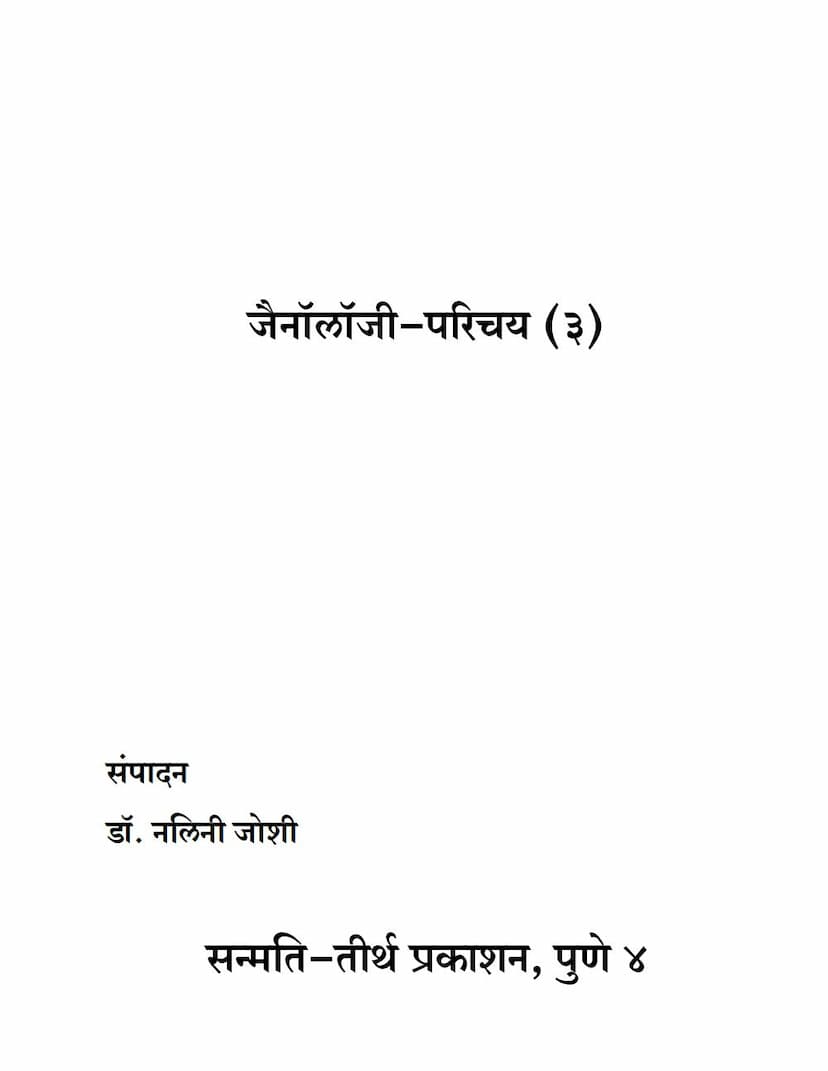Jainology Parichaya 03
Added to library: September 2, 2025

Summary
Here's a comprehensive summary of the Jain text "Jainology Parichaya 03":
This book, "Jainology Parichaya (3)," edited by Dr. Nalini Joshi and published by Sanmati Tirth Prakashan, Pune, is part of a series designed to introduce Jainology. It follows the "Jainology Pravesh" courses for children and builds upon the positive reception of the "Jainology Parichaya" series for teenagers and new homemakers.
Key Content and Structure:
The book is structured into three main sections:
-
Jain Dharma Ki Mulbhut Jankari (Fundamental Information about Jain Dharma): This section provides a foundational understanding of Jainism. It covers:
- Jain History and Mythology: Introduces significant figures and concepts like the Panch Parameshthi (five supreme beings), the 24 Tirthankaras, the 11 Ganadharas (chief disciples of Mahavir), the concept of Tirashath Shalaka Purush (63 exalted persons), and the 16 Satia (virtuous women).
- Tattva Gyan (Philosophy): Delves into core Jain philosophical principles, including the six Dravy as (substances), the nine Tattvas (fundamental realities), the two types of Jiva (soul), the four Gatis (realms of existence), the classification of Jivas based on senses (Ekendriya and Trasajiva), the five Indriyas (senses), and the five types of knowledge (Jnana). It also explains the five elements of Ajiva (non-soul), the cyclical nature of time (Kalachakra), and the four qualities of Pudgala (matter).
- Karma Siddhanta (Theory of Karma): Explains the intricate Jain theory of karma, detailing the eight primary types of karmas and their sub-classifications. It also touches upon the concepts of Ghatikarma (karma that obscures the soul's inherent qualities) and Aghatikarma (karma that does not obscure).
- Karma Bandh Ke Hetu (Causes of Karmic Bondage): Discusses the factors that lead to the accumulation of karma, such as attachment (Raga), aversion (Dvesha), passions (Kashaya), the three yogas (body, speech, mind), and the seven vices (Sapt Vyasan).
- Achar (Conduct): Outlines the principles of Jain conduct, including the Ratnatraya (three jewels: Right Faith, Right Knowledge, Right Conduct), the five Mahavratas (great vows), the five Samitis (careful conduct in movement, speech, etc.), the three Guptis (restraint of mind, speech, and body), and the ten Dharmas (virtues). It also introduces the twelve Anupreksas (reflections) and the six internal and external austerities (Tapa). Finally, it details the Shravakachar (conduct of lay followers), including the twelve vows of Shravakas (according to Shvetambara tradition) and the eleven Pratimas (stages of spiritual progress for laymen according to Digambara tradition).
-
Uttaradhyayan-Sar - Prashnsanch (Essence of Uttaradhyayan - Question Set): This section focuses on the Uttaradhyayan Sutra, considered a highly important scripture in Jainism, comparable to the Bhagavad Gita for Hindus, Dhamma Pada for Buddhists, and the Bible for Christians. The aim is to provide a foundational introduction to this text for young learners.
- It includes a question set based on the "Uttaradhyayan-Sar" book and related materials.
- The examination format includes:
- Memorizing and writing specific verses (Gathas) from Uttaradhyayan.
- Answering objective questions in one to two sentences.
- Writing short essays on specific topics or stories.
- Grammar exercises.
- The book emphasizes that students should prepare using the provided "Uttaradhyayan-Sar" and question set.
-
Prakrit Bhasha Ka Vyakaran (Grammar of Prakrit Language): This section provides an introduction to the Prakrit language, the language used by Lord Mahavir for his sermons to be accessible to the common populace.
- It explains the origin and nature of Prakrit as a natural, spoken language.
- It details Nam-Vibhakti (Noun Declension), covering the seven cases (Prathama, Dwitiya, Tritiya, Panchami, Shashti, Saptami, Sambodhan) for masculine (Vir), feminine (Ganga), and neuter (Van) nouns, providing examples and declension tables.
- It explains Kriyapad ke Pratyay (Verb Endings) for different tenses and moods:
- Vartamankal (Present Tense): Explains its usage and provides verb conjugations.
- Bhutkal (Past Tense): Explains its usage with specific endings found in Ardhamagadhi.
- Bhavishyakal (Future Tense): Explains its usage with two sets of endings and provides examples.
- Agyarth (Imperative Mood): Explains its purpose for giving commands and provides conjugations.
- Vidhyarth (Potential Mood): Explains its use for expressing wishes, suggestions, and obligations, and provides conjugations.
- It includes exercises for identifying root words, their case, and number, and for categorizing verb conjugations based on tense and mood.
Overall Goal:
The book aims to impart a comprehensive yet accessible understanding of Jainology, covering its philosophical underpinnings, historical figures, karmic principles, ethical conduct, and the intricacies of the Prakrit language. It is designed to be a stepping stone for young learners to engage deeply with Jain scriptures and teachings. The publication reflects Sanmati Tirth's dedication to Jain education and research.